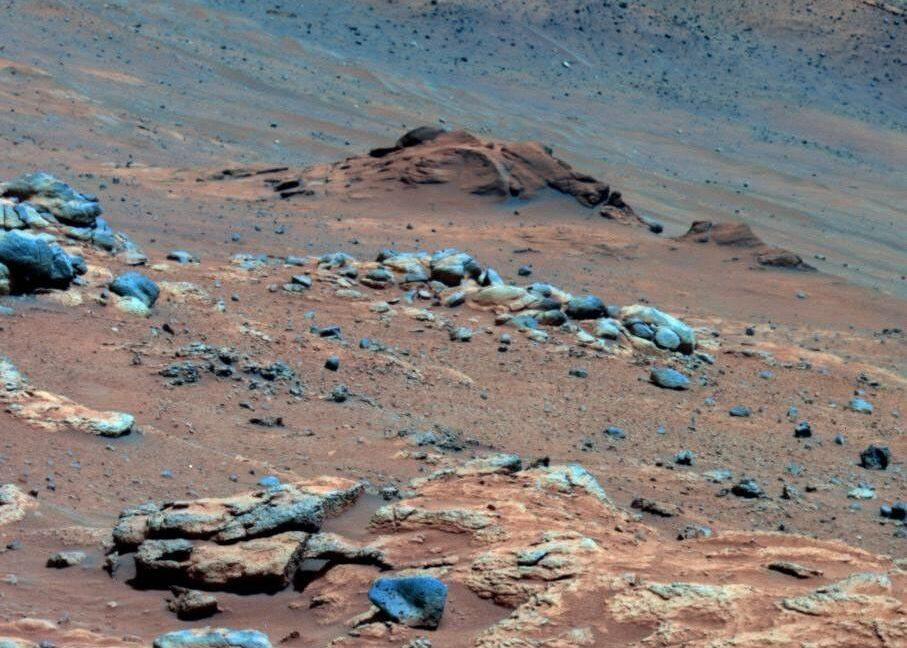The Curiosity rover was sent up the Mount Sharp, the biggest sediments stack on Mars. On the way, it collected samples that indicated a portion of carbon dioxide in the Martian atmosphere might have been sequestered in the sedimentary rocks, just as it happens with limestone on Earth. This would have drawn carbon dioxide out of the atmosphere, reducing the greenhouse effect that warmed the planet.
Based on these findings, a team of scientists led by Benjamin Tutolo, a researcher at the University of Calgary, used this data to conclude Mars had a carbon cycle that could explain the presence of liquid water on its surface. Building on that earlier work, a team led by Edwin Kite, a professor of planetary science at the University of Chicago (and member of the Curiosity science team) has now built the first Martian climate model that took these new results into account. The model also included Martian topography, the luminosity of the Sun, latest orbital data, and many other factors to predict how the Martian conditions and landscape evolved over the span of 3.5 billion years.
Their results mean that any Martian life would have had a rough time of it.
Martian seas
The model Kite’s team built was unique in that it captured evolution of the Martian landscape and climate over an extremely long time. “This has been under development for the last couple of years, along with the paper on the carbonate rocks,” says Tutolo, who was the second author of Kite’s study.
Earlier models we used to simulate long-term climatic changes on Mars lacked spatial resolution, basically treated the entire planet as a single pixel and evolving this pixel over billions of years. On the other hand, models that had high spatial resolution—taking into account all the hills, mountains, and riverbeds—could only be run over relatively short time spans. “To the best of my knowledge, we built the first spatially resolved, long-term climate evolution model for Mars,” Kite said. His team started the run of this new model 3.5 billion years ago, when the planet was at the onset of a period Kite calls the “era of salts.”
“Very early in Mars' history, maybe 4 billion years ago, the planet was warm enough to support lakes and river networks,” Kite told Ars. “There were seas, and some of those seas were as big as the Caspian Sea, maybe bigger. It was a wet place.” This wet period, though, didn’t last long—it was too short to make the landscape deeply weathered and deeply eroded.
Kite’s team used their model to focus on what happened as the planet got colder, when the era of salts started. “Big areas of snowmelts created huge salt flats, which eventually built up over time, accumulating into a thick sedimentary deposit Curiosity rover is currently exploring,” Kite said. But the era of salts did not mark the end of liquid water on the Martian surface.
Flickering habitability
The landscape turned arid, judging by Earth’s standards, roughly 3.5 billion years ago. “There were long periods when the planet was entirely dry,” Kite said. During these dry periods, Mars was almost as cold as it is today. But once in a while, small areas with liquid water appeared on the Martian surface like oases amidst an otherwise unwelcoming desert. It was a sterile planet with flickering, transient habitable spots with water coming from melted snow.
This rather bleak picture of the Martian landscape’s evolution makes questions about our chances for finding traces of life in there tricky.
“You can do a thought experiment where you take a cup of water from the Earth’s ocean and pour it into one of those transient lakes on Mars,” Kite said. “Some microbes in this cup of water would do fine in such conditions.” The bigger question, he thinks, is whether life could originate (rather than just survive) on ancient Mars. And, perhaps more critically, whether hypothetical life that originated even before the salts era, when the planet was warm and wet, could persist in the oases popping up in the Kite’s model.
The answer, sadly, is probably not.
The dry periods were very long, and the lifespan of the oases was geologically short—about one hundred thousand years. “I would say these conditions were harsh enough to extinguish any surface life,” Kite said. Consequently, all the oases in his model were considered uninhabited.
All these predictions about Martian climate should hold if the Kite’s model proves right. But that’s still uncertain.
Journey uphill
Kite admits the Curiosity’s discovery of carbonate rocks on Mount Sharp laid the foundation for the model his team built. “The biggest limitation of this model is that most of the data it’s based on comes from one place and one rover,” Kite acknowledged. If it turned out Mount Sharp was unusually rich in carbonates and thus not representative of Mars as a whole, the model wouldn’t accurately capture its past. Even Curiosity itself, which discovered the carbonate rocks that laid the foundation for Kite’s work with its discovery of carbonate rocks, could still undercut this model with future findings. “What if there is a cessation in carbonate disposition? Looking at the mineralogy in the Mount Sharp itself as we go upwards can put a constraint on that,” Tutolo says.
Another limitation is that the model says nothing about the times before the salts dominated. There was significantly more surface water; the planet must have been much warmer, and we still don’t know what was causing it. “To explain that, we need a non-carbon dioxide warming agent, and I’m trying to figure out what that might be,” Kite said.
Ultimately, the model doesn’t bring us much closer to answering the question about the possibility of life developing on Mars. Kite thinks the chances are still slim, but slightly above zero. He speculates the only place where life could possibly make it through the salt era on Mars is subsurface waters. Potential microbes could survive the dry periods there and move up to the surface to live in the lakes during brief periods of habitability.
“I think we can’t completely close the door on Martian life just yet,” Kite said. He thinks we need to look for biologically produced molecules in ancient Martian rocks. “Curiosity recently encountered long-chain alkanes. On Earth, we’d say this molecule was probably produced by life, which is intriguing. I am very much looking forward to bringing such samples back to Earth for further analysis.”
Nature, 2025. DOI: 10.1038/s41586-025-09161-1

 Luce dal vuoto: la fisica che apre le porte a un nuovo universo
Luce dal vuoto: la fisica che apre le porte a un nuovo universo